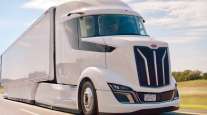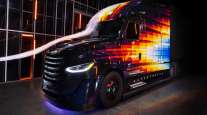Executive Editor
Daimler Unveils High-Efficiency SuperTruck II
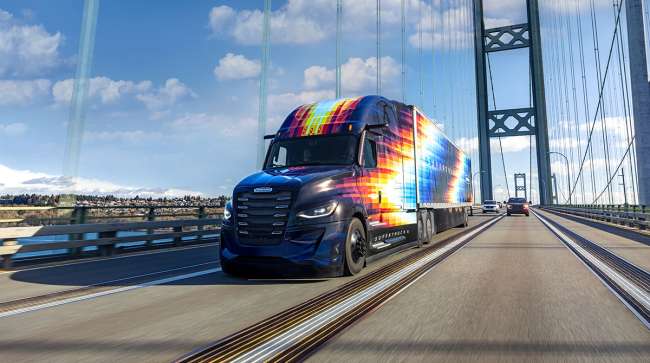
[Stay on top of transportation news: Get TTNews in your inbox.]
LAS VEGAS — Daimler Truck North America has unveiled its SuperTruck II high-efficiency tractor-trailer combination, featuring freight efficiency gains that the company said are built around equipment and components central to real-world tractor-trailer operation.
Unveiled Feb. 1 at the Manifest conference, SuperTruck II — like SuperTruck I developed in partnership with the U.S. Department of Energy — features a more efficient powertrain that achieves fuel economy gains over the SuperTruck I DTNA unveiled in 2015, along with aerodynamic advancements that DTNA said were built around its existing Class 8 designs.
“We focused on technologies and ideas that could be realistically implemented,” DTNA CEO John O’Leary said during a media roundtable Jan. 31 in advance of the truck’s unveiling. “We do not do science projects at DTNA. We stay prudent with our own money, with our investors’ money, and we did it here, too.”
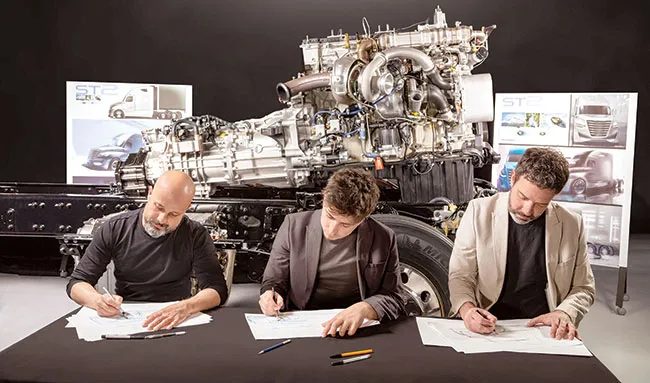
SuperTruck II design engineers by Daimler Truck North America
The SuperTruck program, launched by DOE in 2009, provides funding to truck manufacturers for research and development of technologies and equipment that can help improve heavy-truck efficiency. DTNA is one of several participating in the program, which has undergone two rounds and last year launched a third focused on development of electric technology.
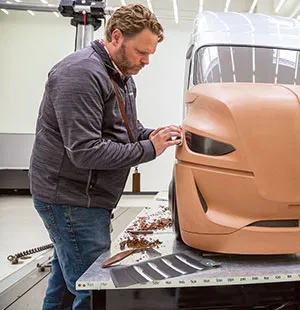
A clay model designer works on SuperTruck II. (Daimler Truck North America)
The $40 million SuperTruck II effort was split between DOE and DTNA, company representatives said.
“Thanks to DOE, the SuperTruck program pushes the envelope, and allows us to take high-risk challenges on ideas,” O’Leary added. “As with SuperTruck I, some of those ideas prove infeasible for the field, but others found their way into production, including things like improved engine thermal efficiency, powertrain integration technology such as downspeeding, and predictive powertrain controls.”
During the media preview, DTNA marketing communications director Samantha Parlier noted that the windshield on the current Freightliner Cascadia — on which SuperTruck II is based — has a design that was developed during SuperTruck I.
SuperTruck II has a redesigned hood, bumper and chassis fairing to improve airflow, while the grille, air intakes and doors are shaped without sharp edges to compromise aerodynamics. Active side extenders and a roof spoiler system close the trailer gap by up to 4 inches at highway speeds, and a system DTNA describes as enhanced aerodynamic height control lowers the truck to ride inches off the ground to realize aerodynamic improvements.

Jeff Cotner by Joe Howard/Transport Topics
“What we do with the project is, we get a chance to experiment and try to find new opportunities from a design standpoint,” said Jeff Cotner, DTNA chief designer. “We wanted to create something that, we felt like, when the viewer sees it they can see the efficiency.”
The truck also replaces outside mirrors with a camera system that reduces aerodynamic drag. The cameras, deployed under a federal exemption from the National Highway Traffic Safety Administration for the program, have been tested in various weather conditions and show potential to enhance driver visibility and improve vehicle safety, DTNA said.
The company’s design and engineering departments worked collaboratively to reduce the aerodynamic drag of SuperTruck II by more than 12% over SuperTruck I.
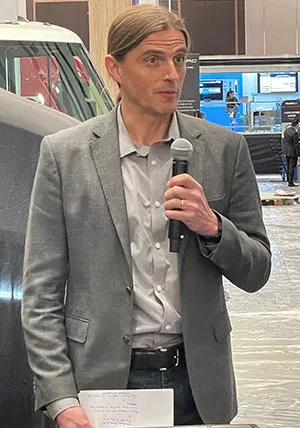
Derek Rotz by Joe Howard/Transport Topics
“Engineering is nothing that we do for engineering’s sake,” said Derek Rotz, DTNA director of advanced engineering. “We always do engineering for a purpose. And the purpose, with the SuperTruck II and with our other engineering projects, is really about transformation.”
The truck’s powertrain, which DTNA said is the most efficient Freightliner has ever integrated into a truck, achieves a 5.7% fuel economy improvement over SuperTruck I. It offers a noncertified prototype Detroit 13-liter diesel engine featuring a two-stage turbo and interstage cooling paired to 13-speed overdrive transmission. Per DTNA, this powertrain achieves lower downspeeding and greater fuel savings through reduced drag overdrive.
DTNA and Detroit, which builds engines and components, are both part of Daimler AG, which is based in Germany.
The truck also features a split cooling system that consists of high-temperature and low-temperature cooling circuits that work in tandem with the turbocharging and exhaust gas recirculation systems.
Also, adaptive axles that shift from 6x4 to 6x2 operation to help extend tire life and reduce rolling resistance at highway speeds, and a tag axle that can be deployed to assist in load-handling and take advantage of the tag axles’ lower rolling resistance. Load-handling can shift automatically from the drive axle to the tag axle.
DTNA collaborated with tire maker Michelin on development of tires specifically for the steer, drive and tag axles. The tire designs include treads and compounds that returned improvements in drive tire wear, and better rolling resistance.
When it comes to keeping the world moving, we are relentless. Always innovating. Always working to exceed our customers’ expectations. That's what drives us - and it drove the development of @freightliner's #SuperTruckII. pic.twitter.com/AcL3rcWVqj
— Daimler Truck NA (@DaimlerTruckNA) February 1, 2023
The truck also features a new 48-volt electrical system that operates the hoteling features without the engine running, while delivering 12-volt power for the standard cab items like lighting or the instrument cluster. The system, which features lithium-ion batteries, powers a new electric steering system that adjusts as demand is needed, depending on if the driver is operating at low or highway speeds. The truck also has a 48-volt starter, and its electric air-conditioning system consumes 50% less energy than the SuperTruck I system.
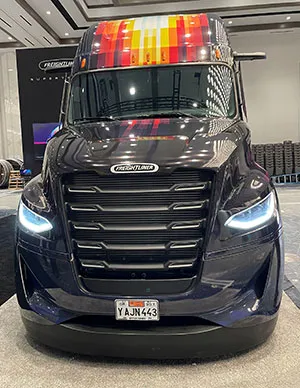
SuperTruck II by Joe Howard/Transport Topics
The electrical system also operates the truck’s EcoSail system, which can shut off the engine without driver intervention when drive power is not needed. If the truck is coasting downhill with the engine off, the 48-volt setup will power systems such as air conditioning. When power is needed, the engine will restart.
This level of development around existing equipment, O’Leary stressed, will help trucking fleets reduce their environmental impact now while advancements in zero-emission technology continue.
“Diesel will remain the predominant propulsion choice for the foreseeable future,” he said, “as it suits 100% of all applications. It remains the most cost-effective and efficient way to move goods and people, and we are far from done with it.”
He added, “This doesn’t mean that we’re not committed to zero-emission, because it’s both. We certainly support zero-emission technology, and see it as the long-term path forward, but there are many challenges to get there. Projects like SuperTruck help us reduce the emissions profile of our fleets now.”
Want more news? Listen to today's daily briefing below or go here for more info:


